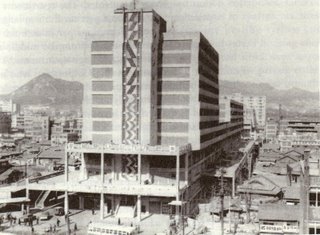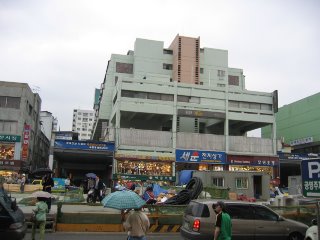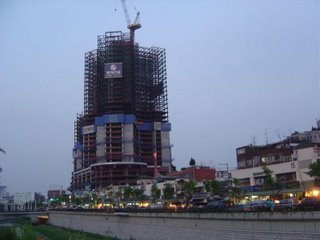This Joongang Ilbo article gives us a hint of things to come in Seoul when Oh Se-hoon becomes mayor:
The mayor-elect of Seoul, Oh Se-hoon, promised yesterday that he would change the city's landscape during his term of office.[...] One of his most prominent campaign pledges was to renovate the dilapidated Sewoon shopping district in the central Seoul district of Jongno, part of a wider pledge to reshape the northern part of the city into something closer akin to the glittering districts south of the Han River. The day after the election, he renewed that promise to scrub Sewoon clean as soon as he takes office.Yes. Renovating Sewoon. Why, that's a new idea. I believe I mentioned it, in passing, recently. This is what the area where it stands today looked like in 1958, nine years before it was built as one of Seoul's earliest redevelopment projects (looking west, with Cheonggyecheon visible on the left and Jongmyo visible on the right):

Completed in 1967, the Sewoon Sangga development contained one of the first high-rise apartments in Seoul, which was 13 stories tall. The entire length of the narrow complex (which is four city blocks long, running north to south in front of Jongmyo) can be seen in this satellite photo. This is what it looked like in the late 1960s when it was first built:

This photo is looking north from Euljiro. The aforementioned 13 story apartment an be seen in the distance, 400 meters away, facing Jongno. This is what it looks like today (looking north from Cheonggyecheon):

The above photo was taken from this site (in Korean), where several pages (1, 2, 3) of photos of the area can be found. The area, as can be seen from the photos, is known for selling electronics. It was also known, as some friends and this Chosun Ilbo article have mentioned, for selling porn videotapes. The plan to redevelop this area has been floating around for at least two years, and likely much longer, as part of a larger strategy of creating a green corridor from Jongmyo to Namsan. This is the design which was chosen for the redevelopment (too bad they didn't go with Jerde's design):

Regarding this redevelopment, the article continues:
The redevelopment will not be welcomed by all; in particular, he will face resistance by merchants currently doing business there, who specialize in electric appliances and products. He promised to work closely with the existing tenants to ease the transition pain.I wonder what kind of measures will be taken to help with these 'transition pains'? When Lee Myung-bak's plans for revitalizing Cheonggyecheon forced the 300,000 merchants operating around the Cheonggye expressway to move in November, 2003 (helped along by thousands of riot police and hired thugs) , they were given the (rather secluded) space inside Dongdaemun stadium to relocate their stalls. This excellent May, 2004 Joongang Ilbo article takes a closer look at the woes of these merchants. At least they were given some sort of public space downtown to sell their wares, right?
He has also pledged to clean up the city's air pollution and give a boost to the old-style markets at Namdaemun and Dongdaemun. He says he wants to demolish Dongdaemun Stadium and improve the shopping districts in the area, which is adjacent to the renovated Cheonggye Stream, the centerpiece of the tenure of his predecessor, Lee Myung-bak.Demolish Dongdaemun stadium? But what about the merchants? Shucks, I really thought former lawyer and national assembly member Mayor-elect Oh cared about the plight of the common people. I'm truly shocked.
Mr. Oh wants to spend 1 trillion won ($1.05 billion) to make Seoul's air more breathable, [according to the Chosun Ilbo, by replacing "800 buses a year in the capital [...] with environmentally friendly vehicles, which over the four years of his tenure will total 3,200 low-pollution buses"] and has proposed more public transportation, perhaps including monorails, to ease traffic congestion.Yes, we have a city with one of the best public transportation systems in the world, with Line 9 and the Incheon Airport-to-Kimpo Airport section of the New Airport line to be finished soon, with extensions to line 7 and line 3, a new Pangyo line, and extensions of the Bundang line to be finished by 2010, and a new Incheon line in the works. What is really needed now is a monorail. My only suggestion is that he not use the man wearing a hat in the picture below as a contractor.

It should also be noted that none of this is new. For several years now, the Seoul city government has been planning all of the things the mayor-elect has suggested above. He is simply continuing the plans set out under Lee Myung-bak's administration. What I do know is that Seoul city made a Central Business District plan presented as a power point presentation back in September 2004, which can be found in pdf format here. There you can see there plans to rebuild the city walls (which seem to have been taken over by the national government's Cultural Heritage Administration), redevelop the entire Sewoon Sangga area from in front of Jongmyo Shrine straight south to Namsan, and redevelop many of the areas next to Cheonggyecheon.
In other news, this month's Seoul magazine has a two page spread about how the greening of Seoul under Lee Myung-bak made Time Magazine's Asia Edition.
The Seoul Metropolitan Government and Mayor Lee Myung-bak are truly blazing a trail for other Asian cities to follow, and the international media continue to take notice of the innovations taking place.Yes, truly, the mayor is 'blazing a trail' for other cities to follow. From Cheonggyecheon to the new town plans, he is 'blazing a trail' through low-income areas, while, if the aforementioned example of the merchants moved to the soon-to-be-demolished Dongdaemun Stadium is any indication, doing very little to address the dislocation his redevelopment projects are causing. This rarely gets discussed in the English language media, and certainly doesn't warrant a mention in Seoul magazine. With fawning coverage like this, you probably won't be surprised to learn that Seoul magazine is funded in part by the city government. On the other hand, it's not as bad is this Far East Economic Review article from January 2004:
Like maybe accept several cake boxes of money to relax height restrictions in the Cheonggyecheon area in order to allow contractors to make a little more profit?For years, Yang Yoon Jae has been leading groups of students along the route of the Cheonggye elevated expressway in downtown Seoul, asking them to imagine how they might reinvigorate the dilapidated neighbourhood. "It's dirty, dusty, noisy, and polluted with bad air. Who wants to live or work along there?" asks Yang, professor of environmental studies at Seoul National University. "We had to do something drastic to change the environment."
Seoul vice mayor Yang Yun Jae, who used to oversee the project, was arrested Friday on charges he took dirty money from a construction contractor. [...] The prosecution says that someone in the construction business gave Yang more than W100 million and asked him to see to it that the height restrictions for buildings in the Uljiro area were relaxed. Many people had from the start been opposed to high-density development along Cheonggyecheon. The Seoul Development Institute issued an opinion about restrictions on high-rises. Despite that the city decided to allow buildings higher than thirty stories high, saying it wanted to prevent downtown from becoming desolate.
I suppose it's no surprise that Seoul magazine hasn't mentioned Yang Yun Jae's role when lauding Lee Myung-bak's accomplishments. The aforementioned Far East Economic Review article gets better, though:
Just like Yang, Lee too had experienced a moment of truth in the underground passage that housed the stream. With the roar of traffic above his head, Lee sidestepped puddles of sewage. Through cracks in the tunnel's roof, shafts of sunlight filtered through. In the light of one, Lee recalls noticing a spot on the ground where a melon seed had taken root and a tiny flower had blossomed. Says Lee, "I was deeply impressed and it brought me to tears."
An appropriate ending to this paragraph, which the Far East Economic Review did not follow through on, would have been to tell us that the future mayor sees that the fragile melon plant is actually dying of a fatal disease and takes it to a plant nursery and tries to nurse it back to health, only to see the plant die in front of him, and as it does so he cries "사랑해, 사랑해" repeatedly with tears in his eyes as he reaches for the dying plant, separated by well meaning (but disapproving) relatives who won't allow him to touch this beloved melon plant which moved him to dismantle the expressway his own former company built and replace it with the stream that once lay below it (with a little help from his friends in the construction industry).
Anyways, the Seoul Magazine article was accompanied by this photo:
This image, with shots of buildings which actually stand in Gangnam portrayed as standing next to Cheonggyecheon (the 'hit product' of last year, let's not forget), and with the "ancient" painted images of mountains and animals, reminds me, to some degree, of the cave paintings in Lauscaux, France, where the most important aspects of their society are portrayed as being together in a single, holistic representation of their lifestyle. On the other hand, seeing these Gangnam buildings being represented as being next to Cheonggyecheon reminded me of this article by Scott Burgeson, where he referred to the "Kangnamification of Jongno", as he described the destruction of a section of Pimatgol (a historic alley which runs behind the north side of Jongno) to make way for this lovely building:
He mentions protests by the proprieters of the establishments which were torn down; these protests are documented by Christian Karl here (where you can see what became of the building in the photo in at the top of his article), while this post shows what the area looked like before it was torn down. Burgeson has another very pertinent article about redevelopment in Insa-dong, which can be found here.
While we're on the topic of redevelopment, after my previous post about Lee Myung-bak, Antti asked me if the Samil Apartments had been torn down yet. I have to admit, I knew nothing about them, but soon dug up some information about them, including the numerous photos on this site (with a few more here). This is what these twenty, 7 storey apartments looked like before Cheonggyecheon was restored (looking south - Doota is visible on the right):

This is what this area looked like last summer, when I walked by this area. The buildings on the northern side of the stream are still standing, but the ones on the south side appear to be gone.

This is a photo taken a week or two ago, from almost the same vantage point. In this photo, it appears as if the apartments on both sides of the stream have been torn down, as a tower begins to grow in the distance:

The Samil Apartments have not yet been torn down, however; only the top 5 floors have been removed. The lower floors containing the stores still remain, but their days are most certainly numbered.

This photo shows both the new apartment building and the line of decapitated apartment blocks:

If you're curious about what these apartment towers are going to look like, here are a few photos of the plans:


The latter photo (from here) makes clear that the Samil Apartment buildings standing in front of these towers will be torn down and converted to open space). The delays that have beset this project (the Hwanghak-dong Lotte Castle) can be read about here (in Korean), while the numerous other redevelopment projects being carried out in the area (and the way in which they are driving up apartment prices there) is discussed here. Some of those projects are related to the new towns planned in the Cheonggyecheon area. As for Cheonggyecheon itself, I found a critical look at the project by Lee Jei-sun, an Urban Engineering professor at Yonsei University can be found here (scroll down).
There's lots more to talk about, but it's time to stop. Before too long I'll comment on the city's plans for downtown, as well as the new town project, and how these redevelopment schemes are, in many ways, related to Cheonggyecheon. These are bold, far-reaching plans, which intend to change the face of the northern part of the city, but little is being said about those who will be negatively affected (even if only in the short term), and those who will be benefitting from these massive redevelopment plans (such as, off the top of my head, construction companies).




1 comment:
Robert -
I remember the days when Seoul magazine was asking for donations to keep it afloat, and though I was aware that city money was now involved, the memory of those days still lingers. I've glanced at a few issues of the magazine over the past few years (picked this issue up at 3 Alleys Pub) but had never paid much attention to the contents page to see that it was co-published by the city. If I'd known that the two-page spread about the Time article was essentially a PSA by the city, I wouldn't have criticized its "fawning coverage"!
In the latest issue there's the article with the photo of the Salgoji Bridge, which I hadn't known existed; it's definitely something I'll have to check out.
Post a Comment